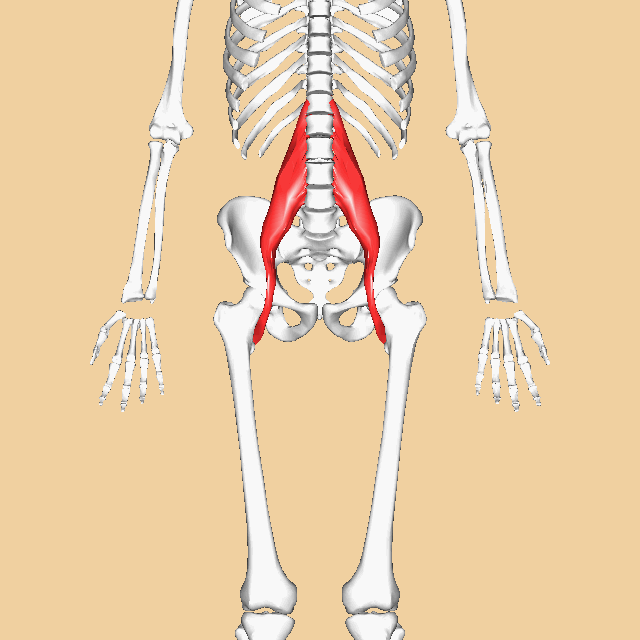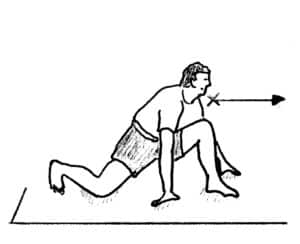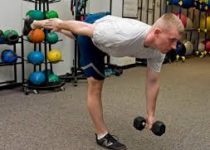The Psoas Muscle Stretch That Nobody Does
It is quite surprising that there hasn't been too much scientific research about the Psoas Muscle. Being one of the most important muscles in your body, you would not want to neglect your psoas.
Still, there are plenty of people with a tight psoas, which causes them trouble in their daily life!
Do you have trouble with your hip flexors? Even back & knee pain often is related to your psoas! If you are looking for possible solutions to release your psoas muscle you are at the right place!
What is the Psoas?
Before diving into our stretching tutorial, you have to understand a little bit of the anatomy of the iliopsoas. But no worries, it is going to be reasonably easy to understand!
The psoas muscle is by far one of the deepest muscles, that you have in your core. Targeting such a muscle can be quite challenging. But besides being hidden, it is also the only muscle, that connects your spine to your legs.
The muscles are going with your femurs to your pelvis and are attached to the 5th lumbar vertebrae all the way up to your 12th thoracic vertebrae.
But that should be enough science & anatomy to gain a better understanding of what the psoas actually does!

Functions:
As mentioned above, the muscle is attached to your hips & spine. Therefore it is by far the most important muscle for any hip movements. As you might imagine, your hip muscles are the most vital muscle that you have! Every time you bend down or to the side, the psoas muscle is going to be engaged. Therefore the health of the psoas is going to influence your every-day life!
Why Do My Hips Get Tight?
This is a very reasonable question to ask? Of course, there are obvious causes for a tight psoas, which could be too much sitting.
But when is it too much? What should you do if you can't avoid sitting too much? Or what if you don't even sit that much but still got a tight psoas?
Here I will go through possible & frequent causes for the psoas syndrome.
Sitting:
When sitting your hips are going to be bent, which sets the psoas in a shortened position. The problem with sitting is, that your muscles adjust to your own behaviour. Muscles basically work in a use it or lose it concept. Therefore the hip flexors/ your psoas are going to be shortened when sitting on a regular basis. Psoas pain is going to arise. One positive aspect about it is, that you can loosen up hip flexors with the right exercise & stretches!
Even when sitting for extended periods of time every single day, you can avoid tight hip flexors/psoas by investing time in the right activities!

Posture:
Another problem that causes psoas tightness is the wrong posture. Overall, the psoas muscle is a vital muscle if you want straight posture. But even with a healthy iliopsoas you still have room for posture mistakes. The two most common problems in regard to posture are anterior & posterior pelvic tilt.
To the left side, you can see an illustration covering the most common errors in posture caused by your hip rotators. Anterior & posterior pelvic tilt, should be avoided when standing straight.
Therefore we wanted to remind you of having good posture when standing. But also proper sitting posture shouldn't be neglected! The psoas has a significant influence on your posture.
How It Affects The Quality Of Your Life
But why should you put all that effort into the psoas muscle? Are the problems that the psoas muscle causes when being tight actually that bad? Those questions might still be prevalent in your mind. But we hope to be able to motivate you for a psoas release in this section!
As the iliopsoas is one of the most vital muscles in your entire body, its dysfunction is going to affect pretty much every single aspect of your life! The psoas muscle flexes the hip and is going to cause pain when being tight.
Tight psoas muscles will make both sitting & standing painful and annoying. Despite that, the simple movement of picking up something from the floor is going to be an issue if you neglect this muscle!
Unfortunately, there are even more issues, that stand in direct & painful relation with tension in the psoas.
Lower back pain is one of many examples, which is caused by bad posture. On the other hand, bad posture is usually related to hip flexor problems.
Another issue that you might face is knee problems. If your hips are stiff & weak, they are not going to be able to help with absorbing impact while walking & running. Therefore, the hip flexor is going to play an important role if you want to fix knee-pain.
In fact, it has been proven, that strengthening of the hip flexors improves knee stability as much as directly working on your knee stability muscles.
If you have trouble with knee pain you should check out this book, which explains more in detail how knee pain & tight hip flexors stand in relation.
There are more problems that can be related to the psoas, which is why we heavily recommend taking care of it!
Why Psoas Muscle Release Is So Hard
But what do we mean by taking care? How do you loosen up your psoas muscle? Those questions are going to be covered in this section.
The most apparent problem with the psoas is, that it is deep inside your body, making it challenging to stretch & to release its pain. Furthermore, massage is not as easy as with other muscles, because it is hard to target the psoas.
Besides that, it is not as intuitive to stretch muscles around your hip flexors as it is with shoulders, arms & legs.
Stretches That Help
Before explaining some of the best stretches, we want to remind you that stretching alone is usually not enough to solve more severe problems. Often it is best to integrate strength & mobility exercises, to get the best results!
Lunge Stretch
With the lunge stretch, you want to start by going into a lunge position. Once you are in that position your aim is to push your hips forward as much as you can. This is going to stretch a significant part of your psoas muscle.
Furthermore, you can increase the stretch, by adding anterior pelvic tilt. Simply think of moving your pelvic bone closer to your center of gravity. By doing so you will be able to release tension.

Thomas Stretch
With the next stretch, you are going to start by sitting on the edge of a table or something slightly higher than the average chair. The next step would be to pull one of your legs towards your chest, while the other leg is going to hang down. By doing so you should feel a pull around your hip flexors.
Since the stretch is a one-sided stretch you have to do the stretch on both sides!
Watch the Video below if you haven't heard of this stretch before
How To Approach Stretching - Release Psoas Muscle[s] Quickly
Stretching only helps when applied the right way. In this section, we will explain how to stretch the psoas muscle!
There has been a lot of confusion with different stretching methods. Should you do PNF stretching, dynamic stretching or static stretches? What is the best method & how long and frequent should you do stretches?
Different Stretching Methods
If you did not hear all the stretching methods before, you can find a short explanation of each method in this section! Especially PNF stretching is something most people are not aware yet since it is a very new way to stretch. Also avoid intense pain when stretching!
PNF Stretching
Many people argue, that PNF stretching is by far the fastest way to achieve more range of motion & flexibility.
PNF stretching can be divided into the following steps:
- Get into a position that stretches & puts the muscles under tension that you are about to stretch
- Then you contract the muscle that you want to stretch for roughly 4-6 seconds. It is important, that you are not moving the body part during that period of time. Therefore it would make sense to take a partner/object that keeps the body part at the same place
- Now you are going to do the actual stretching part. Stretch the body part for roughly 20-30sec.
Once you went through this process once, you should rest for about 30 seconds and then repeat the process 2-3 more times for optimal results
Dynamic Stretching
One advantage of dynamic stretching is, that you can easily include it in your warm-up, as it helps to increase blood flow. At the same time, it is known, that static stretches are going to decrease your explosive strength if you do them right before training.
Therefore we recommend you to do dynamic stretching if you are about to go through an exercise.
Overall, doing a dynamic stretch is less complicated than PNF stretching. One of the best examples for dynamic stretches for your hip flexors would be a straight leg swing. By doing that in all directions you are going to increase your hip flexibility & strength at the same time.
Even though it sometimes feels less like stretching than a static position, it is proven to be at least as effective as a static stretch.
If you want a better scientific overview of different stretching methods & nerve muscle relations you can browse through the study.
Static Stretching
Static stretching is pretty much self-explanatory. You simply go into a position that applies tension to the body part that you are going to stretch. Once you are in the position you should hold it for at least 30 seconds if you want optimal results. Focus on your core muscles being engaged. You should repeat the stretch for 2-3 times with small breaks in between.
Interested in an in depth comparison of dynamic vs static stretching?
How Long & Often?
Most stretching methods require different periods of being under tension. But the frequency is similar to many stretches.
We recommend stretching between 5-7 times per week, for optimal results. But surprisingly there was no difference in terms of results between stretching five & seven times per week.
Stretching 3-4 times per week is still going to give you excellent results and is enough for most people if you lack the time.
Problems
Often stretching is perceived as the solution to everything. Furthermore, stretching can actually have negative influences on muscular dysbalances when done the wrong way.
One problem that you can run into is overstretching. When overstretching you are actually going to increase the risk of injury, which is something to avoid. Especially very enthusiastic athletes & people tend to overstretch.
The easiest way to avoid overstretching is by listening to your body. While you should feel the tension and a slight pull you should never feel a stabbing or pain, when in your stretching position.
The nervous system has a mechanism to protect your muscles from stretching too far when being tight.
Think about being relaxed when stretching. Even listening to calm music can help you. At most you should avoid forced stretching as it will rather work against your ROM and increase the risk of injury!
Sometimes It's Not Enough!
Another issue is the perception that people have of stretching. In many cases, it is seen as the solution to all problems. But in fact, stretching is not going to improve muscular dysbalance. Especially if you confuse weakness with tightness, you are going to harm your own body.
If you stretch your psoas, while the actual problem is a weakness, you are going to be more prone to the wrong posture.
You have to know how to strengthen the psoas muscle and also understand how to differentiate between weakness & tightness.
What Now?
If you have tight hip flexors the best step would be to start stretching. But remember the paragraph above!
In case everything still seems fairly confusing to you, we recommend you to acquire more information about your hip flexors.
Personally I went through the book "unlock your hip flexors" when I faced problems with my psoas the first time.
Read my review on the book for more information!
Conclusion
The psoas is one of the most important muscles in our entire body. But still, there is not a lot of research about it. Even when going to the doctor or when doing physical therapy people confuse psoas problems with different muscle issues.
Even knee & lower back pain are frequently caused by problems with your psoas! We recommend you to not only stretch but also to work on strength & mobility!


